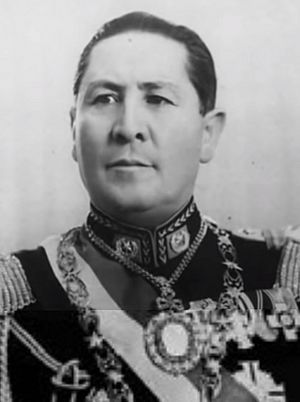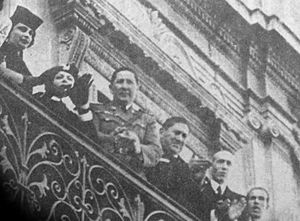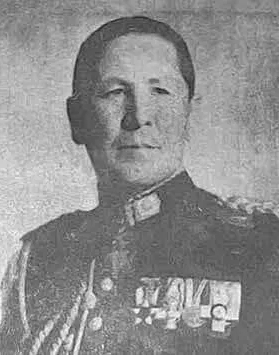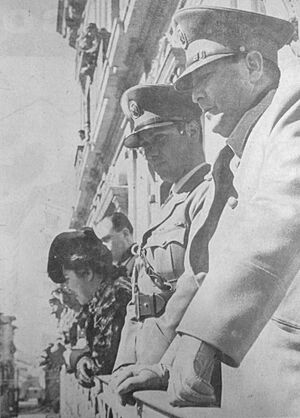Carlos Quintanilla facts for kids
Quick facts for kids
Carlos Quintanilla
|
|
|---|---|
 |
|
| 37th President of Bolivia | |
| In office 23 August 1939 – 15 April 1940 |
|
| Vice President | Vacant (1939) None (1939–1940) |
| Preceded by | Germán Busch |
| Succeeded by | Enrique Peñaranda |
| Ambassador of Bolivia to the Holy See | |
| In office 1940–1941 |
|
| President | Enrique Peñaranda |
| Pope | Pius XII |
| Preceded by | Gabriel Gosálvez |
| Succeeded by | Eduardo Arze Quiroga (as chargé d'affaires) |
| Personal details | |
| Born |
Carlos Quintanilla Quiroga
22 January 1888 Cochabamba, Bolivia |
| Died | 8 June 1964 (aged 76) Cochabamba, Bolivia |
| Spouse | Lila Navajas Trigo |
| Parents | Jenaro Quintanilla Carlota Quiroga |
| Education | Military College of the Army |
| Signature |  |
| Military service | |
| Allegiance | Bolivia |
| Branch/service | Bolivian Army |
| Rank | General |
| Battles/wars | Chaco War
|
Carlos Quintanilla Quiroga (born 22 January 1888 – died 8 June 1964) was a Bolivian general. He became the 37th president of Bolivia for a short time, from 1939 to 1940. He served as a provisional (temporary) president. Quintanilla fought in the early parts of the Chaco War (1932–1935). He rose through the ranks of the Bolivian army to become its commander during the time of President Germán Busch. When President Busch passed away on 23 August 1939, Quintanilla stepped in and declared himself the provisional President of Bolivia.
Even though Quintanilla hoped to stay in power longer, strong pressure from different political groups made him call general elections for 10 March 1940. He had promised to continue the social and economic plans of President Busch. However, his short time as president was spent changing the laws made by previous military governments. He worked to bring back the older, more traditional political parties that were in power before the Chaco War.
Contents
Early Life and Military Career
Carlos Quintanilla was born on 22 January 1888, in the city of Cochabamba, Bolivia. His parents were Jenaro Quintanilla and Carlota Quiroga. In 1906, he left his hometown to finish high school.
Joining the Army
In 1907, he moved to La Paz, the capital city, to continue his studies. He joined the Military College of the Army. In 1911, at 23 years old, he graduated as a second lieutenant in the army.
To learn even more about military strategy, Quintanilla traveled to the German Empire in 1912. There, he took special courses with the German army. He even became a deputy chief for the German General Staff. In 1914, he returned to Bolivia because World War I had started in Europe.
Back in Bolivia, Quintanilla became an instructor at the Military College of the Army. For a short time, he also worked as an Aide-de-camp (a personal assistant) to President Ismael Montes. Between 1915 and 1916, he became a lieutenant, and by 1920, he was promoted to captain.
Further Studies and Promotions
Quintanilla went back to Germany in 1922, after the war had ended. He continued his military studies there. In 1923, while still abroad, he was promoted to major. However, he was discharged from the Bolivian army that same year by President Bautista Saavedra. He rejoined the Bolivian army in 1926 as a Lieutenant Colonel. President Hernando Siles Reyes appointed him as Bolivia's military representative in Germany.
After returning from Germany, he commanded different infantry groups between 1927 and 1928. He became a colonel in 1929. That same year, he was put in charge of the 4th Division of the Bolivian Army in the Chaco region. This area was being disputed with Paraguay. In 1929, Quintanilla sent a report to his leaders, warning them about the situation of the country and the army.
In 1930, President Carlos Blanco Galindo made Quintanilla Bolivia's military attaché in Germany. As an attaché, Quintanilla worked on different missions in various European countries until 1931. He returned to Bolivia for the last time in 1931. He then commanded the First Division of the Bolivian Army and was also the Deputy Chief of the General Staff.
Chaco War
In July 1932, President Daniel Salamanca asked General Quintanilla to become the Chief of Staff of the Bolivian Army. However, Quintanilla and the current Chief of Staff, General Filiberto Osorio, made a different plan. Osorio would stay, and Quintanilla would lead the Bolivian forces in the southeast Chaco. So, on 25 July 1932, Carlos Quintanilla was put in charge of the First Army Corps.
By 1932, the disagreement between Bolivia and Paraguay over the Chaco region was very serious. In June, Bolivian soldiers captured a fort. The next month, Paraguayan soldiers took it back. In response, President Salamanca ordered General Quintanilla to capture three Paraguayan forts: Corrales, Toledo, and Boquerón.
Battle of Boquerón
On 7 August, Bolivian forces took over the Paraguayan Fort Carayá. This was part of General Quintanilla's plan to move towards Isla Poí, which was a main base for the Paraguayan army. But before his plan could fully start, on 9 September, Quintanilla faced the first attack from Paraguay. This attack was led by Lieutenant Colonel José Félix Estigarribia. Quintanilla had been told that Paraguay would attack with 6,000 men, but he didn't believe it. During the Battle of Boquerón, Quintanilla never fully understood how many enemy soldiers there were or what their plans were. It became clear that President Salamanca had chosen him for his organizing skills, not for his skills as a battle leader.
Being Replaced
After Boquerón was lost, President Salamanca decided to change the army's top leaders. Quintanilla was replaced by Bernardino Bilbao Rioja. Quintanilla left his command on 11 October 1932. He did not return to the front lines until January 1935, after President Salamanca was removed from power. Quintanilla then took part in the Battle of Villamontes as the General Commander of the Central Sector, during the final part of the Chaco War.
Return to Power
After Bolivia lost the Chaco War, many military officers, including Quintanilla, blamed the old political leaders for the country's failure. However, Quintanilla and other older, more traditional officers were worried about the big changes being made by the "Military Socialist" governments of David Toro and Germán Busch.
Despite his concerns, Quintanilla was made commander-in-chief of the armed forces during Germán Busch's presidency. Busch, though experienced in the army, was new to politics. He allowed Quintanilla to remove younger, more liberal officers from important positions. From the day he was appointed, Quintanilla began removing officers who were seen as too involved in politics. President Busch eventually stopped this under pressure from groups who feared that their allies were being replaced.
Taking Over the Presidency in 1939
On 23 August 1939, President Germán Busch passed away. General Quintanilla quickly went to the government palace, the Palacio Quemado, and took control with the military. The military said they took over because the president was gone. However, the Vice President, Enrique Baldivieso, was still alive. So, the military also argued that the Vice President had given up his right to become president months earlier when Busch had dissolved the assembly and become a dictator.
Months later, on 4 December, Quintanilla changed a part of the 1938 Constitution. He completely got rid of the vice presidency. He claimed that the position was "not needed by public needs or by the political traditions of the country."
Provisional President (1939–1940)
President Busch died at 2:45 p.m. Soon after, Quintanilla spoke to the nation on the radio. He announced that "the life of the greatest Bolivian citizen... has just been tragically ended." In the same speech, the general declared himself the provisional president.
Quintanilla had promised that his government would "continue the plans and directions of the social and economic policy of Colonel Busch." However, his main actions as president were to start moving the country back to how it was before the war. This meant returning power to the wealthy families and groups, even with their problems, because it brought some stability. On 19 October 1939, Quintanilla temporarily stopped a rule that required mining companies to give 100% of their foreign money to the government. This allowed mining companies to keep the foreign money from their exports, undoing what Busch had ordered. His choice to print money without proper backing caused inflation, meaning prices for basic goods went up. This made the country's difficult economic situation even worse.
Because he moved the country away from the "military socialism" era, two senators suggested he be promoted to the very high rank of Marshal of Bolivia. This title had not been held since Andrés de Santa Cruz and Otto Philipp Braun. The idea failed and was made fun of by the public. Quintanilla himself was given the mocking nickname "El Loco Mariscal" (The Crazy Marshal).
1940 General Election
Even though Quintanilla wanted to stay in power longer, he couldn't ignore the pressure from both the wealthy families and the younger military officers. Because Quintanilla took a long time to call elections, General Enrique Peñaranda told the news that the country urgently needed "direct general elections." Peñaranda was supported by a new group called Concordance. This group was a mix of older, traditional parties, and they were backed by the powerful mining families. These parties sent a message to the president. They said that delaying elections without good reasons would make people believe that their vote would not truly count. Because of this pressure, Quintanilla's government finally announced elections on 6 October 1939, to be held on 10 March 1940.
Military College Uprising
General Bernardino Bilbao Rioja, who took over from Quintanilla as commander-in-chief of the army, was considered a possible presidential candidate. Bilbao was seen as a hero of the Chaco War and was popular among former soldiers. He also led the Legion of Veterans, which gave him support among younger officers.
To keep the power with the older officers, Quintanilla took steps to stop opposition. On 25 October, Bilbao was called to the government palace to meet with the president. As soon as he arrived, he was attacked and beaten until he was unconscious. He was then taken to a train station and sent away to Arica. After this, Quintanilla said that he had accepted Bilbao's departure to protect the country's peace. Later, the Chief of the General Staff, Antenor Ichazo, said he was responsible for the attack. He claimed Bilbao was planning a coup (a sudden takeover of the government).

The attack on Bilbao made many young military officers very angry. They threatened to rebel against the government. Eleven men from the Military College of the Army, led by its director Lieutenant Colonel Sinforiano Bilbao (Bernardino Bilbao's brother), published a statement saying they did not recognize Quintanilla as president. They armed themselves and threatened to bomb the Palacio Quemado. However, their uprising did not get much public support, and government forces surrounded the college.
At the same time, another military school in Cochabamba also protested. A group of officers from Cochabamba met with Quintanilla in La Paz. They reached an agreement. Quintanilla agreed to put Bernardino Bilbao back in his position as commander-in-chief within ten days. He also promised to keep Sinforiano Bilbao as director of the Military College and not punish any military members who took part in the uprising. In return, Sinforiano agreed to stop the protest.
However, Quintanilla soon broke his promises. Bernardino Bilbao was not allowed to return to his post. Instead, he was made a military attaché in London, which was like a disguised exile. Sinforiano Bilbao was removed from his position and sought safety in the Chilean Embassy.
The Camperada
General elections were held on 10 March 1940. Because opposition leaders had been suppressed, Peñaranda won easily with 58,060 votes. His opponent, José Antonio Arze, received only 10,000 votes. There was a small problem during the change of power on 26 March. Some people who had attacked Bilbao thought they could start their own coup. This event was called the "Chapaco Putsch" because its leaders were from Tarija. Early on 26 March, Antenor Ichazo and the police took up arms and took over the entrances to the Plaza Murillo. However, when Quintanilla woke up and saw the troops, he ordered them to leave. Seeing that the plan was failing, Ichazo changed his mind and sided with the president.
An investigation later showed that Ichazo was supposed to become president. The event was named the camperada because its leaders shared the last name Campero. After the failed revolt, there was a demonstration in the plaza against the coup. Supporters of the Concordance, government employees, and left-wing figures joined it. Quintanilla gave speeches promising to punish the plotters, but no one was ever executed.
Peñaranda became president on 15 April 1940, ending Quintanilla's temporary time in office.

Later Years and Death
After Peñaranda became president, Quintanilla left the government palace. He moved to Rome, where he served as Bolivia's ambassador to the Holy See (the government of the Catholic Church) until 1941.
Carlos Quintanilla died in his hometown of Cochabamba on 8 June 1964. He was 76 years old.
See also
 In Spanish: Carlos Quintanilla Quiroga para niños
In Spanish: Carlos Quintanilla Quiroga para niños
- Cabinet of Carlos Quintanilla




